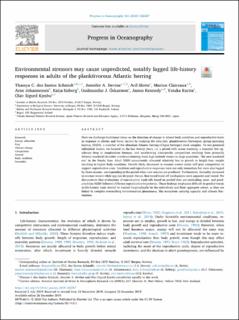Environmental stressors may cause unpredicted, notably lagged life-history responses in adults of the planktivorous Atlantic herring
dos Santos Schmidt, Thassya Christina; Devine, Jennifer Ann; Slotte, Aril; Claireaux, Marion; Johannessen, A; Enberg, Katja; Oskarsson, Gudmundur; Kennedy, James; Kurita, Yutaka; Kjesbu, Olav Sigurd
Peer reviewed, Journal article
Published version
Permanent lenke
https://hdl.handle.net/11250/2683353Utgivelsesdato
2020Metadata
Vis full innførselSamlinger
- Articles [3012]
- Publikasjoner fra CRIStin [3070]
Originalversjon
10.1016/j.pocean.2019.102257Sammendrag
Here we challenge traditional views on the direction of change in teleost body condition and reproductive traits in response to abiotic and biotic factors by studying the data-rich, planktivorous Norwegian spring-spawning herring (NSSH), a member of the abundant Atlantic herring (Clupea harengus) stock complex. To test potential influential factors, we focused on the last twenty years, i.e. a period with ocean warming, a transient but significant drop in zooplankton biomass, and accelerating interspecific competition resulting from primarily Atlantic mackerel (Scomber scombrus) entering these high-latitude waters in large quantities, “the new mackerel era” in the Nordic Seas. Adult NSSH concurrently allocated relatively less to growth in length than weight resulting in higher body condition. Growth likely decreased in warmer waters under stiff prey competition to support reproductive costs. Condition and reproductive responses were not only immediate but were also lagged by three seasons, corresponding to the period when new oocytes are produced. Furthermore, fecundity increased in warmer waters while egg size dropped. Hence, fine-tuned trade-off mechanisms were apparent and varied. We demonstrate that evaluations of reproductive trade-offs based on pooled data are misleading; poor- and good-condition NSSH followed different reproductive trajectories. These findings emphasize difficult-to-predict trends in life-history traits should be tracked longitudinally by the individuals and their aggregate cohort, as they are linked to complex overarching environmental phenomena, like ecosystem carrying capacity and climate fluctuations.
